Etymology and Names of Passion flower(Passiflora)
Passion Flower is also called Passiflorina, Passion Vine, Maypop,
Flower of the Five Wounds, Water Lemon, Apricot vine, Passionaria, Passionblume. It is called
Jhumkalata and
Ghari bel in Hindi, Krishna Kamala
in Marathi, Jhumkalata in
Bengali, Radhika nachom in
Manipuri, Tella Jumiki in
Telugu, Kukki Belli and
Krishna Kamala
in Kannada, Cirran cantia in
Malayalam, and sirupoonaikali
in Tamil. In Oriya we call it
Radha Tamala and
in some areas panchu pandab.
 |
| Passiflora Soi Fah |
Passion flower is a genus of over 530 species of flowering plants. Its botanical name is
Passiflora(family-Passifloraceae).
Passion flower vine produces very beautiful white flowers with purple,
blue, or pink calyx crown blooms. The blooming period is from May to
July but it flowers almost all the year round.
It is a perennial climber
with a woody stem that grows to a length of nearly 15–20 m height where
support is available. The leaves are alternate, palmately five-lobed
10–18 cm long and wide. The flower is complex, about 10 cm diameter,
with the five sepals and petals similar in appearance, whitish in
colour, surmounted by a corona of blue or violet filaments, then five
greenish-yellow stamens and three purple stigmas. The fruit is a smooth,
yellow, ovate berry containing numerous seeds. Passionflower is very
easy to propagate through root division or by seed. A lattice or fence
could be provided near it for good growth, since it is a climbing vine
with tendrils seeking a support.
It’s said that
passionflower got its name because its corona resembles the crown of
thorns worn by Jesus Christ during the crucifixion. It symbolizes
Christ's suffering on the cross. It is more commonly known as the crown
of thorns. I have often heard in my area that this flower resembles a
rakhi which is worn on the
wrist of every brother on
Rakshya Bandhan festival all
over India as the symbol of a sister’s love for her brother. It’s one of
my favourite flowers. Its colour, fragrance, shape, the vine, the
leaves; everything about it is simply unique and magically
beautiful.
 |
| Passiflora Foetida |
Some species produce small berry-like fruit called granadilla or water
lemon. The aerial parts of the plant are gathered during fruiting season
and then dried for future processing.
The leaves, stems, and flowers are used for medicinal purposes. Passion
plant is anodyne, antispasmodic, anxiolytic, aphrodisiac, aromatic,
narcotic and sedative.
Passion Flower is a
Natural Tranquilizer. It reduces spasms and depresses the central
nervous system.
It is commonly used for pain relief, as a sedative, hypnotic,
antispasmodic, neuralgia (pain along a nerve), diarrhea, dysentery,
generalized seizures, nervous tachycardia (abnormally high heart rate),
spasmodic asthma, epilepsy, and other conditions of hyperactivity, as
well as high blood pressure, hysteria, nervous agitation,
dysmennorhea (painful menstruation), and hemorrhoids.
Passionflower (Passiflora incarnata) was used traditionally in
the Americas and later in Europe as a calming herb for anxiety,
insomnia, seizures, and hysteria. It is still used today to treat
anxiety and insomnia. A decoction of passion flower has been
successfully used in bronchial asthma. It has been used in Europe and
America as a healing for burns; extract of the herb have a marked effect
on inflammations. Early research indicated that an extract of passion
flower was effective against the disturbance of menopause.
Still larger doses of passion flower extract causes hallucinations,
convulsions, and vomiting. Oral doses of 250-350 mg will produce
distinct psychotic symptoms, full of hallucinations, followed by
pronounced central nervous system depression. Hence, passion flower is
sometimes used as a mild hallucinogen. The ancient Aztecs reportedly
used passionflower as a sedative and pain reliever. But unlike other
sedatives passionflower is non-addictive. Passion Flower Tea benefits
have been recognized for over 200 years by the Native Americans as
effective in sedating and calming the nerves. The parts of the plant
(flowers, leaves, and stems) are used for medicinal purposes. Passion
Flower may reduce chemical reactions that cause nausea and vomiting as a
result of withdrawal from drugs like cocaine, heroin etc., and this may
prove useful as a support for those patients trying to withdraw from
such dangerous addictives.
Passionflower Herbal Tea Recipe
-
Boil 1 cup(include stems) water for 10 minutes.
-
Put about 1 tsp. of
dried herb into it.;
-
Strain and cool the
extract.
-
For anxiety, during the
day drink 3 - 4 cups per day.
-
For insomnia, drink 1
cup an hour before going to bed.
Passionflower is generally considered to be nontoxic when used in
moderation. Many herbalists prescribe 3 to 4 cups a day without any
problems reported. But passionflower extracts should never be given to
anybody who is already under medication for anxiety or depression for it
could lead to excessive sleepiness. Also remember that blue
passionflower or Passiflora caerulea, should not be used, as it does not have the same activity.
Passionflower should not be given to pregnant or lactating mothers.
N.B. All the above is solely for informational purpose and NOT INTENDED
TO PROVIDE ANY KIND OF MEDICAL ADVICE. A REGD. AYURVEDIC/MEDICAL
PRACTITIONER SHOULD ALWAYS BE CONSULTED FOR IT.
 |
| Krishna tamala |
 |
| The leaves of passion vine |


